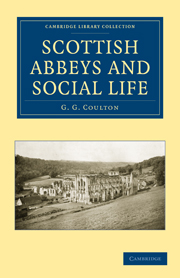Book contents
- Frontmatter
- Contents
- LIST OF ILLUSTRATIONS
- Preface
- Chapter I Celtic Monachism
- Chapter II The Monastic Rules
- Chapter III Monastic Revenues
- Chapter IV How Endowments Came (I)
- Chapter V How Endowments Came (II)
- Chapter VI Monks and Parishes (I)
- Chapter VII Monks and Parishes (II)
- Chapter VIII Charity (I)
- Chapter IX Charity (II)
- Chapter X Monk and Peasant (I)
- Chapter XI Monk and Peasant (II)
- Chapter XII Monastic Housekeeping
- Chapter XIII Church and Scriptorium
- Chapter XIV The Monastic Chronicler
- Chapter XV Schools
- Chapter XVI Art and Learning
- Chapter XVII Professions and Business
- Chapter XVIII Visitation (I)
- Chapter XIX Visitation (II)
- Chapter XX A Voice from the Cloister
- Chapter XXI Conclusion
- Appendixes
- List of Authorities
- Index
- Frontmatter
- Contents
- LIST OF ILLUSTRATIONS
- Preface
- Chapter I Celtic Monachism
- Chapter II The Monastic Rules
- Chapter III Monastic Revenues
- Chapter IV How Endowments Came (I)
- Chapter V How Endowments Came (II)
- Chapter VI Monks and Parishes (I)
- Chapter VII Monks and Parishes (II)
- Chapter VIII Charity (I)
- Chapter IX Charity (II)
- Chapter X Monk and Peasant (I)
- Chapter XI Monk and Peasant (II)
- Chapter XII Monastic Housekeeping
- Chapter XIII Church and Scriptorium
- Chapter XIV The Monastic Chronicler
- Chapter XV Schools
- Chapter XVI Art and Learning
- Chapter XVII Professions and Business
- Chapter XVIII Visitation (I)
- Chapter XIX Visitation (II)
- Chapter XX A Voice from the Cloister
- Chapter XXI Conclusion
- Appendixes
- List of Authorities
- Index
Summary
Here, again, the documentary evidence dictates serious modifications of the popular view; and, indeed, of some views which claim more than mere popular authority. Simultaneously with these Rhind Lectures Dr Patrick McGlynn, M.A., Lecturer in Humanities at the University of Glasgow, is reported to have spoken thus at the Lauriston Hall, Edinburgh, under the presidency of Archbishop Macdonald, O.S.B.: “To the monasteries we owed the preservation of many of the greatest classics of Greece and Rome. Scholarship was regarded as a sacred trust.… The monasteries of the Benedictines, especially, performed very valuable work by allotting certain time each day to be devoted to labour in the Scriptorium; and the results of their labours fed the printing presses of a thousand years later.… To-day… we were rapidly losing the power of thinking”. The whole lecture is headed “Decay of Scholarship” (Scotsman, Dec. 15, 1931).
To this it must be answered that the foundation of all sane thinking is to avoid transgressing the limits of recorded fact, and that not even the most enthusiastic writer, among real specialists of any creed in monastic history, has attempted to bring evidence for the popular legend that the average monk spent an allotted time daily in the Scriptorium. That the monasteries did preserve most precious classical manuscripts is perfectly true; but we must not forget those which they lost or destroyed. At Bobbio in the Apennines, in the thirteenth century, there was a priceless collection; yet large numbers were systematically scraped away to make room for modern writing.
- Type
- Chapter
- Information
- Scottish Abbeys and Social Life , pp. 175 - 186Publisher: Cambridge University PressPrint publication year: 2010First published in: 1933

